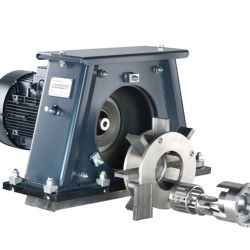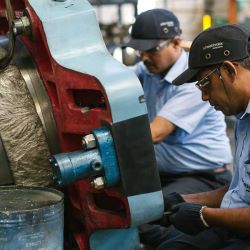“One by one, we’re removing the remaining ‘black boxes’ in and around the shot blast process”
Can you tell us briefly what the main characteristics are that separate our three wheel families?
The typology is not 100% strict, but in broad terms, the families are combinations of direct drive versus belt-driven and tool steel versus cast parts across a wide range of motor powers. We’ve left enough room for variations within those that we can offer quite specific wheels while still being able to get new innovations rolled out across wheel designs quickly.
What kind of innovations are we talking about? Is there really that much room for improvement?
There is still a lot of room for improvement in the wheel! The closer we look, the more complex it becomes. There are so many interactions within the blast wheel, between its components and the abrasive. Understanding and controlling all that fully is a science.
Plus, our customers’ worlds change all the time. Energy prices go up, so energy efficiency becomes important. Sustainability moves up the agenda, so demand increases for emission tracking. There’s a labor shortage, so minimal maintenance moves into the spotlight. Integrated lines become more common, so predictability and continuous operation become paramount.
There are a few constants as well, though. The R&D focus areas we’re looking at all the time are wear, energy use and speed of maintenance.
Tell us more about wear!
Our R&D around wear is about finding ways of wear-optimizing parts and offering the best selection of wear part materials to suit different requirements. For example, we have wheels with tool steel parts that are incredibly durable, but we’re always working on making other materials more durable too.
Sometimes it’s not the material alone that makes the difference, it could be the casting or machining process or the heat treatment. That’s where our testing capabilities come in. We’ve got a fantastic test center in Germany, with a materials lab attached. It allows us to challenge assumptions and let evidence guide our developments.
And of course, wear is not just determined by the quality of the wear parts. Sometimes you see curious wear patterns that are caused by a small design feature in the core wheel assembly. Because we have global R&D resources, we can get to the bottom of what’s going on.
Apart from testing, what other tools do you use to improve the wheel?
There have been a lot of developments over the last decade. We’ve looked inside the wheel with high-speed cameras and are increasingly using laboratory work to get under skin of parts. But the biggest step change in just how much of the blast process we can see comes from digital process monitoring. There’s just so much more data available.
The range of digital tools and sensors is growing all the time. One by one, we’re removing the remaining ‘black boxes’ in and around the shot blast process. Whether that’s real-time abrasive monitoring, which could be a game-changer for peening, or simply a holistic view of machine behavior over time that can give us important insights. Of course, the main reason behind the tools is to improve our customers’ processes and save them money, but it’s also fueling our R&D.
"For me, wheel blasting will always be a high-tech process. As experts on the equipment, it’s our job to ensure the “high-tech” aspect is invisible, built into the machine. That’s the real engineering challenge! "
Stanislav Venclik - VP Portfolio Development Manager
Would you say wheel blasting is becoming a high-tech process?
I’d say it already is – even in applications that are not usually considered “high-tech”, whether that’s cleaning in foundries or occasional blasting in fabrication and assembly, there are always new challenges and ways to push the technology.
Castings have changed hugely over the last decade and the blast process has to adapt to the challenges that come with that. Foundry lines are getting more digitalized and integrated, so there’s an expectation that shot-blast equipment keeps up with that - delivering data points, offering opportunities to correct and control.
Stanislav, thank you for your time!


